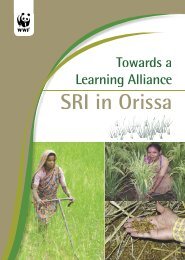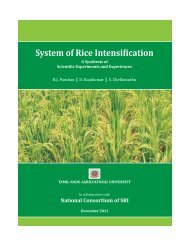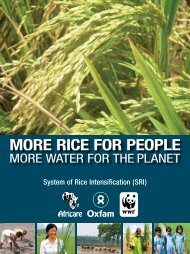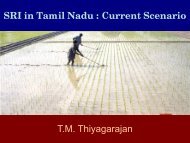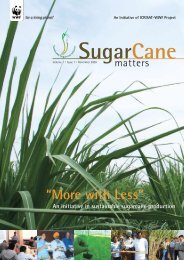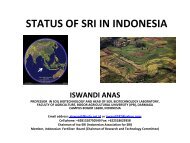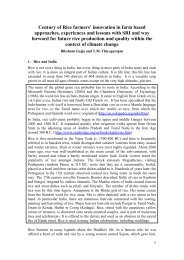Sustainable Sugarcane Initiative (SSI) manual - SRI - India
Sustainable Sugarcane Initiative (SSI) manual - SRI - India
Sustainable Sugarcane Initiative (SSI) manual - SRI - India
You also want an ePaper? Increase the reach of your titles
YUMPU automatically turns print PDFs into web optimized ePapers that Google loves.
Step-wise Guide to <strong>SSI</strong> Practices<br />
8. Fertilizer application<br />
Nutrient management in sugarcane cultivation is very essential<br />
for crop growth.<br />
• It is always better to know the required quantity of nutrients<br />
through soil testing and enrich the soil accordingly. If there is<br />
no facility for that, then NPK can be applied at the rate of 112<br />
kg, 25 kg and 48 kg per acre, respectively through inorganic or<br />
organic methods.<br />
• Inorganic fertilizers like Urea, Super Phosphate, Muriate of<br />
Potash and Ammonium Sulphate are applied to achieve the<br />
above mentioned nutrient requirement.<br />
• It is observed that by practicing appropriate cultivation<br />
practices like wider spacing, mulching and earthing up, the<br />
required quantity of NPK can be achieved by applying optimum<br />
or less quantity of these fertilizers.<br />
• The recommended quantity of fertilizers can be applied in 2 to<br />
3 split doses for the efficient utilization by plants.<br />
• Further, by applying organic manures at the time of field<br />
preparation and incorporation of green manures into the<br />
soil, sufficient quantity of nutrients can be supplied for<br />
plant growth.In addition, application of bio-fertilizers like<br />
Azospirillum and Phosphobacteria, 2 kg each on 30 th and 60 th<br />
day after planting by mixing it with FYM (200 kg/acre) would<br />
also improve the crop growth. This can be applied in the sides<br />
of furrows and incorporated into the soil while earthing up.<br />
9.Water management<br />
It is always better to provide sufficient quantity of water on time<br />
rather than flooding the field with enormous amount of water.<br />
• In conventional flooding method water is always applied more<br />
than the biological demand of the crop which may affect the<br />
crop growth.<br />
• After transplantation, the frequency of the irrigation may<br />
differ depending on the soil type, age of the crop, rainfall and<br />
moisture availability. For sandy soil, the frequency will be more<br />
and for clay soil it will be less.<br />
• Give irrigation once in 10 days during tillering stage (36-100<br />
days), once in 7 days during Grand Growth period (101-270<br />
days) and once in 15 days during Maturity period (from 271<br />
days till harvest).<br />
Fertilizer application<br />
It is essential to<br />
apply micronutrients<br />
like iron, zinc,<br />
manganese, copper,<br />
molybdenum<br />
and boron after<br />
considering their<br />
deficiency in the soil.<br />
Water requirement<br />
for sugarcane<br />
records an average<br />
of 1500 mm (i.e. 60<br />
lakh litres/acre for<br />
full season) including<br />
rainfall, to produce<br />
100 t millable<br />
canes. However, in<br />
conventional method<br />
of flood irrigation,<br />
2000 mm (80<br />
lakh litres/acre) of<br />
water is applied by<br />
irrigation alone.<br />
Drip irrigation<br />
Improving <strong>Sugarcane</strong> Cultivation in <strong>India</strong> 21





